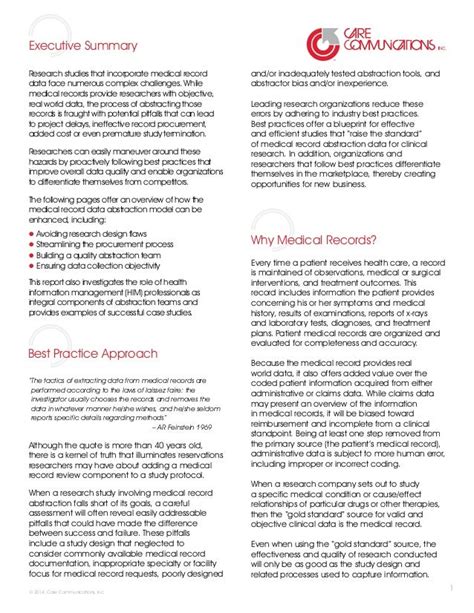Medical Records to Data: A Simple Abstraction Process
The healthcare industry is awash in data. Patient charts, lab results, imaging reports – the sheer volume of information is staggering. However, this raw data is largely unusable in its native form. Transforming these medical records into structured, analyzable data is crucial for research, improving patient care, and driving efficiency. This process, known as data abstraction, is a critical step in unlocking the potential of healthcare information. This article will explore a simplified approach to this complex process.
What is Medical Record Data Abstraction?
Medical record data abstraction involves extracting specific pieces of information from unstructured medical records and transforming them into a structured format suitable for analysis. This might involve translating free-text notes into coded values, standardizing data formats, or creating a relational database from disparate sources. The goal is to create a clean, consistent dataset that can be used for various purposes. Think of it as translating a complex, handwritten novel into a concise, well-organized summary.
Why is Data Abstraction Necessary?
The inherent complexity of medical records makes direct analysis nearly impossible. Information is often scattered across various documents, using different terminologies and formats. Data abstraction solves this by:
- Standardizing data: It brings uniformity to diverse data sources, allowing for easier comparison and analysis.
- Improving data quality: It helps identify and correct inconsistencies and errors present in the original records.
- Facilitating data analysis: Structured data is easily processed using analytical tools, enabling valuable insights.
- Enhancing research: Clean, standardized data is essential for conducting robust medical research.
- Improving patient care: Data analysis can lead to better diagnoses, treatment plans, and overall patient outcomes.
The Simple Abstraction Process: A Step-by-Step Guide
While the specifics vary depending on the project's scope, a simplified data abstraction process generally follows these steps:
1. Define Objectives and Scope: Clearly outline what information needs to be extracted and the purpose of the analysis. This will dictate which data points are crucial and which can be ignored.
2. Data Source Identification: Identify the specific medical records that will be abstracted. This might include patient charts, lab reports, radiology images, and billing records.
3. Develop a Data Dictionary: Create a detailed data dictionary that defines each data element to be abstracted, including its data type, format, and acceptable values. This ensures consistency throughout the process.
4. Choose Abstraction Methods: Select appropriate methods for extracting data. This could involve manual chart review, automated natural language processing (NLP) techniques, or a hybrid approach. Manual abstraction is accurate but time-consuming, while NLP can be faster but requires careful validation.
5. Data Abstraction: This is the core of the process where the data is extracted and formatted according to the data dictionary. Rigorous quality control measures are essential here.
6. Data Validation and Cleaning: Thoroughly review the abstracted data to identify and correct errors. This often involves comparing the abstracted data to the original source documents.
7. Data Storage and Management: Store the abstracted data in a structured format, such as a relational database, for easy access and analysis.
8. Data Analysis and Reporting: Use appropriate analytical tools to analyze the data and generate reports that answer the initial objectives.
How to Choose the Right Abstraction Method?
- Manual Abstraction: Best for complex or nuanced data requiring human interpretation, but slower and more expensive.
- Automated Abstraction (NLP): Faster and more cost-effective for large datasets, but requires careful validation and may miss subtle details.
- Hybrid Approach: Combines manual and automated methods, leveraging the strengths of both for optimal accuracy and efficiency.
What are the Common Challenges in Medical Record Data Abstraction?
- Inconsistent Data Formats: Medical records often come in various formats, making standardization challenging.
- Data Quality Issues: Errors and inconsistencies in the original records can affect the accuracy of the abstracted data.
- Data Security and Privacy: Strict adherence to HIPAA regulations is critical when handling sensitive patient data.
- Scalability: Abstraction can be time-consuming for large datasets, requiring efficient processes and technologies.
What are the potential benefits of effective data abstraction?
Improved clinical decision-making, enhanced research capabilities, optimized resource allocation, reduced operational costs, and better patient outcomes.
By following these steps and addressing the potential challenges, healthcare organizations can effectively transform their medical records into valuable, actionable data, leading to significant improvements in patient care and operational efficiency. The key is to choose the right approach based on the specific needs and resources available. Remember, the goal is not just to abstract data, but to extract meaningful insights that improve health outcomes.

